Data Analysis
This first table shows the SE’s Watts/10 Delta Temp numbers in a quick glance chart format.
Using the data compiled from the G2 Slim thermal testing I have compiled the following tables in an attempt to show another way how the G2 Slim performance varies against itself at the flow rates and fan speeds tested. First let’s look at the raw W/10DT data:
Using the data compiled from the G2 Slim’s thermal testing I have compiled the following tables in an attempt to show other ways of how its performance varies against itself at the flow rates and fan speeds tested. Effectively these show percentage gains relative to a reference point. It’s an interesting way to show gains/losses while changing a variable.
First let’s focus on 1300 RPM as our reference and see how much gain or loss in performance we get by changing fan speed.
This shows that flow rate changes are small but not insignificant.
We can also focus on 1300RPM as our reference and see how much gain or loss in performance we get by changing fan speed:
As expected the change is dramatic. Lastly we can combine both and choose 1300 RPM and 1.0 GPM as our reference point to show both effects concurrently:
So from the data above we can get a very good idea of how the G2 Slim radiator performs relative to itself. But there is a large selection of 360mm radiator models to choose from, released from numerous manufacturers. So, we need to start comparing performance between them.
Push Only Data vs Competition
Let’s focus on the Push Only results for now and come back to the Push/Pull data later. While for Push/Pull we tested three flow rates, the Push Only testing was conducted only at 1GPM in order to save time. For a comparison vs thicker radiators make sure to check out the 2015 Rad Round Up which compares 27+ radiators including the SE.
Let’s start with Push only data where from what we’ve seen we would expect the G2 Slim to do it’s best:
Compared to the other slim radiators, the G2 Slim starts off in the middle of the pack. At 750 RPM the HWLabs Nemesis GTS really throws down the gauntlet for what a slim radiator could acheive here. The G2 Slim is significantly behind the GTS at 750RPM, but is also clearly ahead of the weakest performers.
At 1300RPM the G2 slim places 2nd has reeled in the margin that it trails the GTS and notice the Koolance and it’s very high FPI count is unleashing it’s cooling potential.
At 1850RPM the G2 Slim grabs a 3rd place, ~7% behind the winning Koolance rad.
Most users won’t be interested in choosing a slim radiator in order to run push/pull fans with, but we include the data here for completeness:
At 750RPM the G2 slim is just behind the ST30 and a but further behind the GTS.
At 1300RPM the G2 slim is beating the ST30 and EX, but is still lagging behind the GTS and Koolance which has taken a clear lead.
At 1850RPM it still performs in the middle of the pack of our slim radiator group.
Let’s also combine the Push Only and Push/Pull results at the 1.0 GPM flow rate into one plot for each fan speed tested. These plots show how well the best slim radiators performed against the competition, while showing the G2 Slim’s Push/Pull performance against the other rad’s Push Only results.
Again the 750 rpm first:
The plots are quite busy, but the colors should help seperate out push and push/pull as well as the G2 slim’s standings.
Now 1300RPM:
and at 1850 RPM
From all of test results we created “Average Performance Factor” charts for both Push and Push/Pull and then a combined plot called the “Master Performance Factor”. The radiator with the best cooling ability (W/10ΔT) at each gpm/rpm combo was awarded a score of 100, and each other radiators W/10ΔT result was scored as percentage of the top performer.
This way of looking at the comparison takes away any advantages that a radiator may have at higher or lower fan speeds and looks at an overall average. While this appears fair it does tend to favor those radiators that are all-rounders and those radiators which do very well at high RPM. Most users should be more focused on their specific use case. Check in the Round Up for performance comparisons at every gpm/rpm combo for even more details and cross comparison results.
Here is the G2 Slim 360’s Push/Pull percentage scores at each data point that thermal tests were conducted at and additionally the 1.0 gpm Push Only percentages relative to the winner at each fan assembly.
Looks like a mixed bag of lollies, but what it tells us is that the G2 Slim actually performed reasonably well in each test that was conducted. With just a few exceptions, it was within 10% of the winner at each data point. Obviously it would have been better if it was winning those data points, but it wasn’t disgraced with terrible results.
Then we started averaging the percentage scores at each flow rate giving us the Averaged Performance Factors of each radiator.
Firstly – the Push Only APF:
While we can clearly see the GTS far in the lead the G2 Slim results averaged out very nicely indeed, taking the 2nd top spot – Nice Work !!!
In Push/Pull the G2 Slim drops a spot to 3rd and we see the Koolance catapulting into 1st place with it’s higher FPI .
So I think that a 2nd and a 3rd place in the 2 fan assemblies tested is a commendable effort and those results should average nicely into a good overall score.
Finally we created the Master Performance Factor which is calculated from the averaged results of all the thermal tests, Push and Push/Pull at all flow rates and all fan speeds.
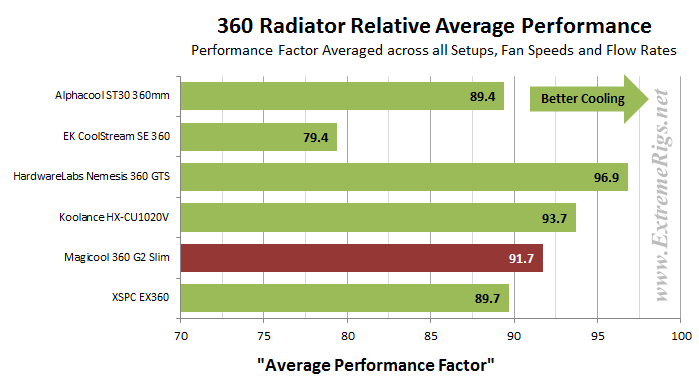 Very nice, Thank You very much. Consistent results across the tests ended up seeing the G2 Slim placing 3rd overall among our slim rads.
Very nice, Thank You very much. Consistent results across the tests ended up seeing the G2 Slim placing 3rd overall among our slim rads.
Next up – Summary!








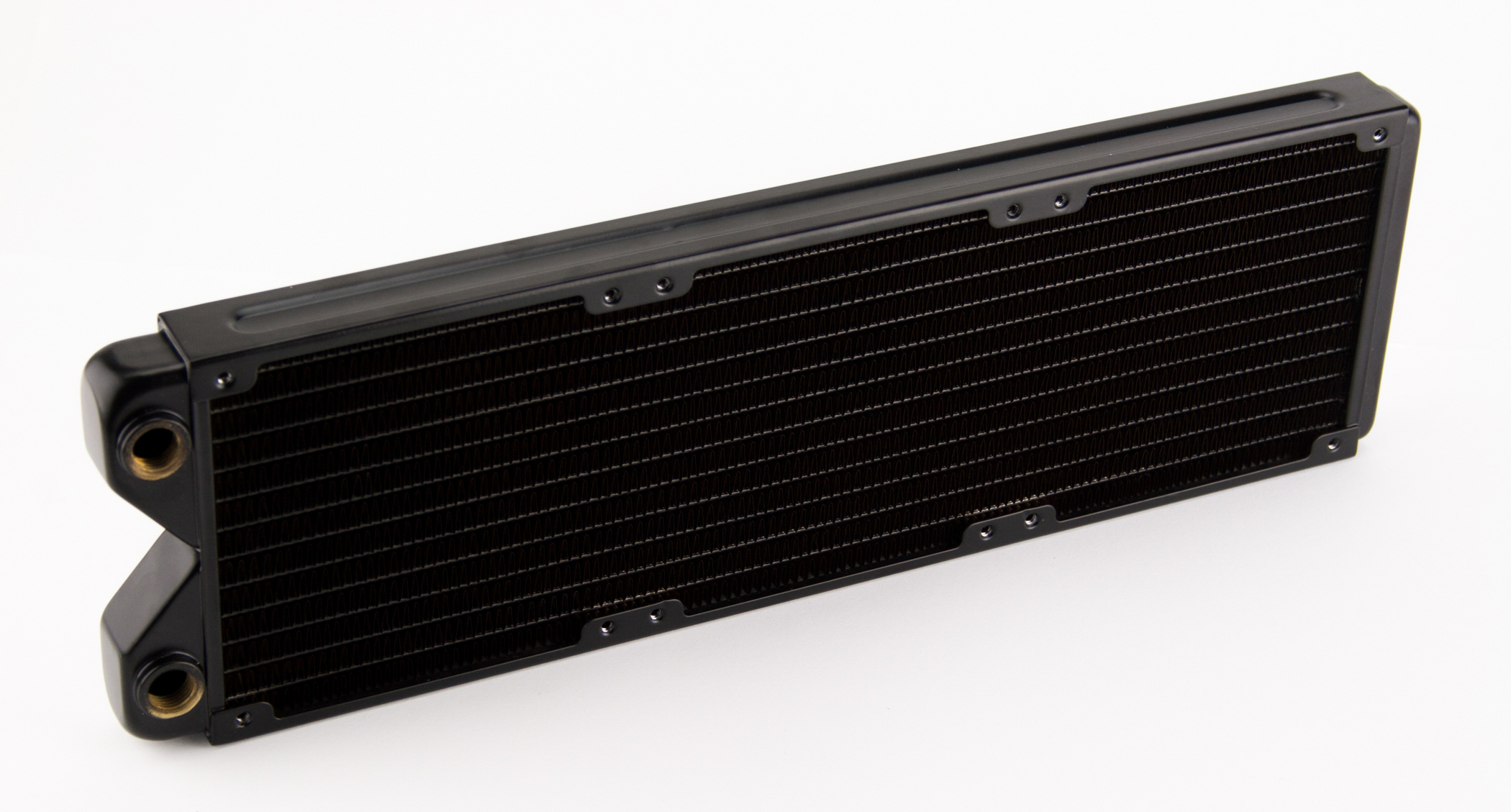
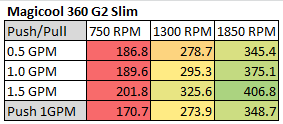
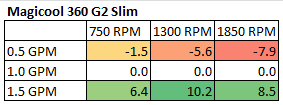
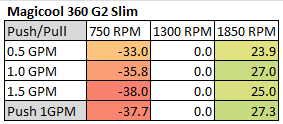
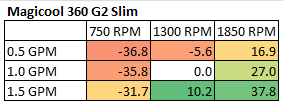
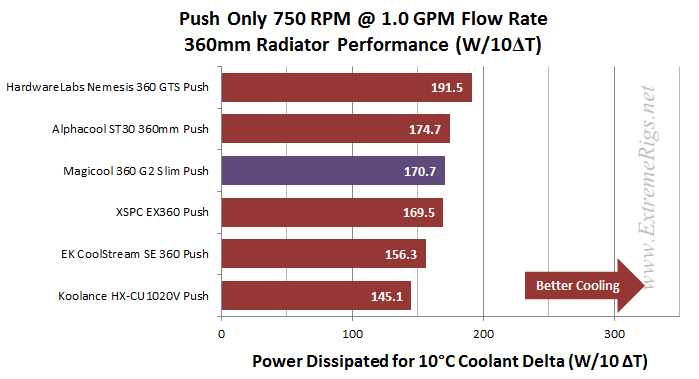
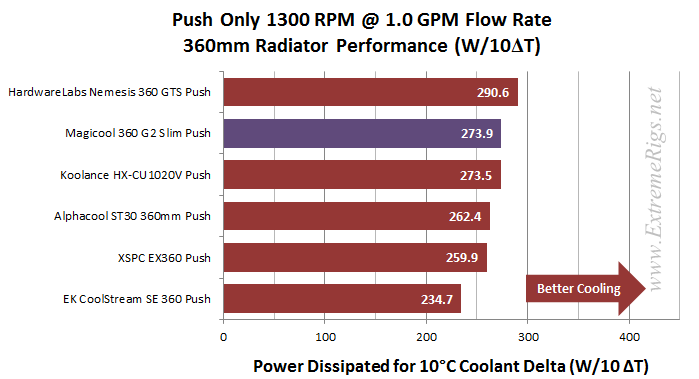
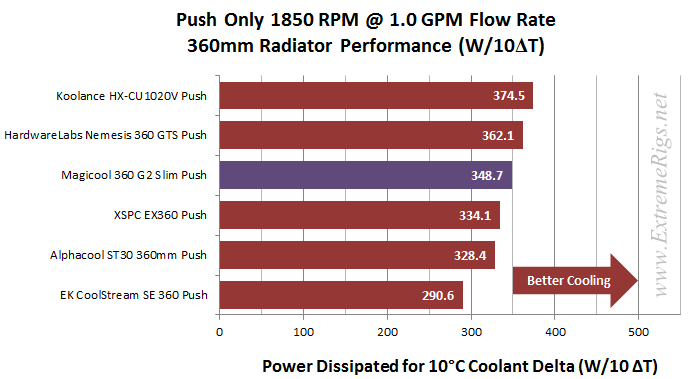
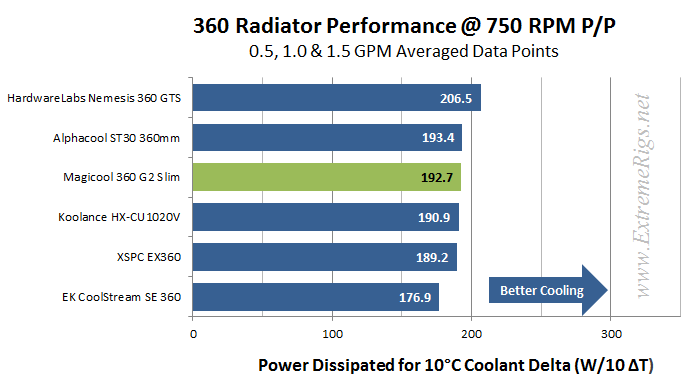
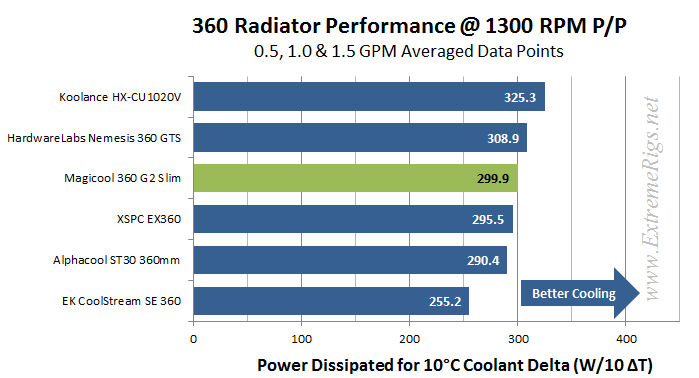
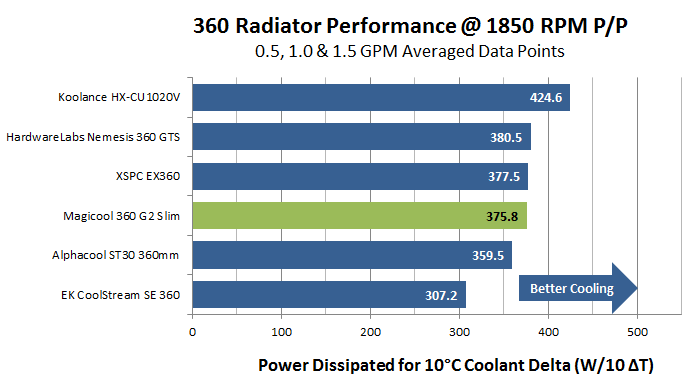
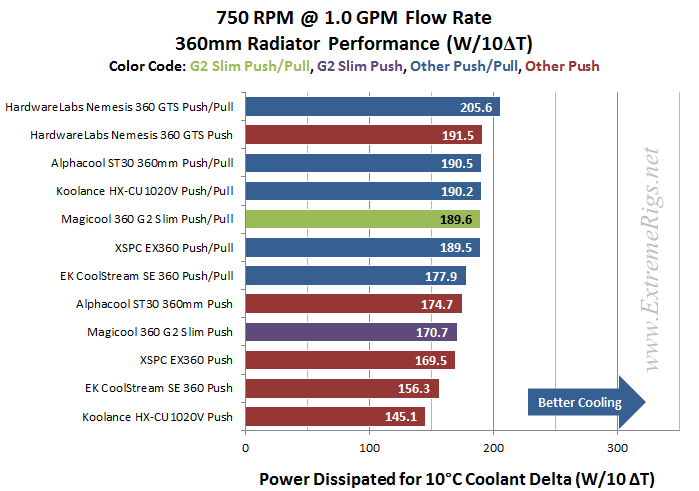
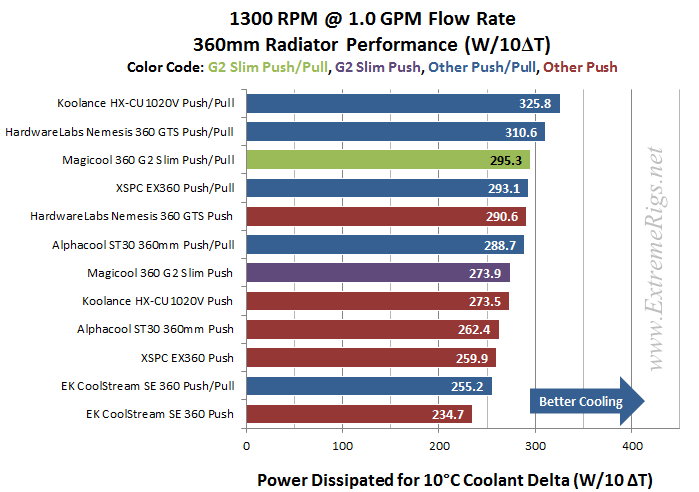
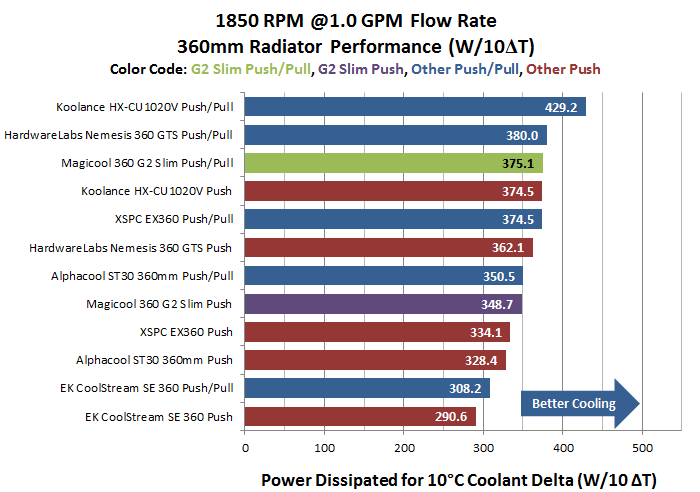
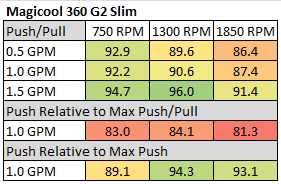
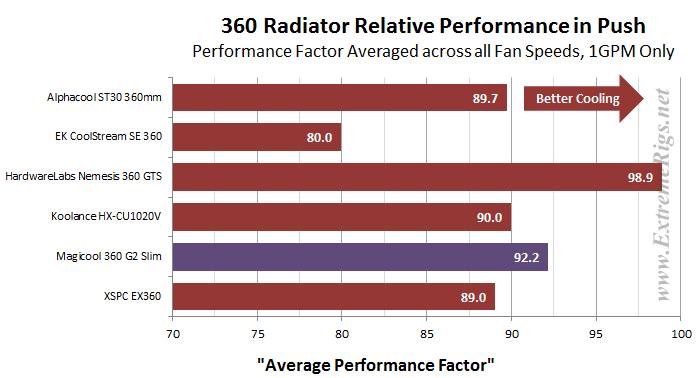
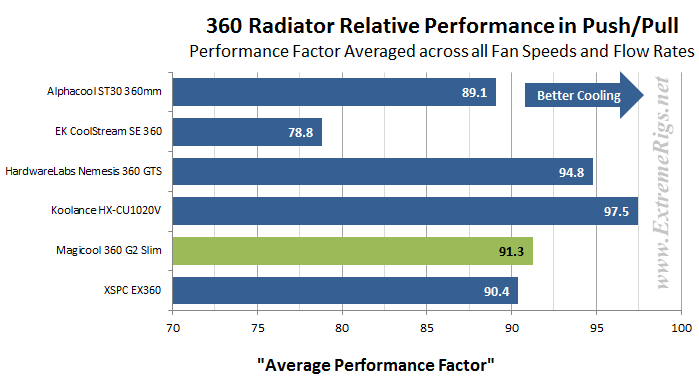




[…] Hardware Labs SR-1 360 Radiator Hardware Labs SR2 360 Radiator Koolance HX-360XC 360 Radiator Magicool G2 Slim 360 Radiator Mayhem’s Havoc 360 Radiator Phobya G-Changer HPC 360 Radiator Phobya G-Changer V2 Full Copper […]
Comments are closed.